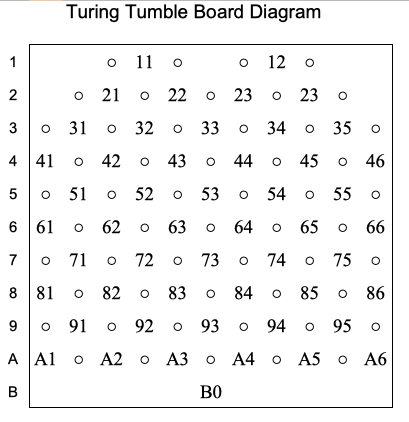There are three common standards for labelling a hex-grid. One is to label the rows and the diagonals in one direction (so, for example: 1A, 1C, 2A, 2B, 2C, 2D, 3A, 3B, 3C, 3D, 3E, 4A, 4B, 4C, 4D, 4E, 4F, 5B, 5C, 5D, 5E, 5F, …, 10D, 10E, 10F, 10G, 10H, 10I, 11G). Another is to label the rows and each individual column (so 1D, 1H, 2C, 2E, 2G, 2I, 3B, 3D, 3F, 3H, 3J, 4A, 4C, 4E, 4G, 4I, 4K, 5B, 5D, 5F, 5H, 5J, …, 10A, 10C, 10E, 10G, 10I, 10K, 11F). The third is to give adjacent pairs of columns (or single zig-zag columns) the same label (so 1B, 1D, 2B, 2C, 2D, 2E, 3A, 3B, 3C, 3D, 3E, 4A, 4B, 4C, 4D, 4E, 4F, 5A, 5B, 5C, 5D, 5E, …, 10A, 10B, 10C, 10D, 10E, 10F, 11C)
Which is best depends on how it’s going to be used - each has its own advantages and disadvantages. The first means that a ball will either stay in the same letter or go up to the next letter each time it drops, but means that later rows start with higher letters. The second means the ball changes to an adjacent letter each time it drops a row, but rows alternately start with A and B, and horizontally adjacent locations don’t have adjacent letters. The third makes it easiest to tell which letter something is, since each row starts with A, but balls will sometimes stay the same letter, and sometimes go to an adjacent letter, with which is which depending on the row number.
For Turing Tumble, I’m inclined to suggest a labelling system based on the two diagonals, like so: 3A, 1C, 4A, 3B, 2C, 1D, 5A, 4B, 3C, 2D, 1E, 6A, 5B, 4C, 3D, 2E, 1F, 6B, 5C, 4D, 3E, 2F, … 9D, 8E, 7F, 6G, 5H, 4I, 7G - each time you drop to the left, the number increases by 1; dropping to the right increases the letter by 1. Of course, it does make reading numbers off the board a little trickier - the secret is that the number plus the letter is a constant for each row, though that constant is three more than the row number - and the middle of each row is either the one where number and letter are equal, or the two where they differ by one, depending on whether you’re looking at an odd or even row.
